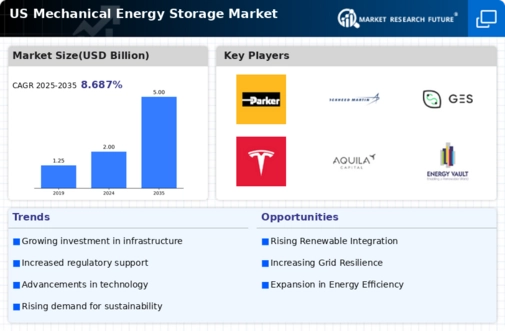Investment in Infrastructure Development
Significant investments in energy infrastructure are propelling the mechanical energy-storage market forward. The US government and private sector are allocating substantial funds to modernize the energy grid, which includes integrating advanced storage technologies. The Infrastructure Investment and Jobs Act, enacted in 2021, earmarked billions for energy projects, including storage solutions. This influx of capital is likely to enhance the deployment of mechanical energy storage systems, which are essential for managing energy fluctuations and improving grid resilience. As infrastructure development progresses, the mechanical energy-storage market is poised to benefit from increased adoption and technological advancements.
Rising Energy Costs and Economic Pressures
Rising energy costs and economic pressures are also influencing the mechanical energy-storage market. As electricity prices continue to climb, there is a growing incentive to invest in energy storage solutions that can mitigate these costs. Mechanical energy storage systems can store energy during off-peak hours when prices are lower and release it during peak demand when prices are higher. This capability not only provides cost savings but also enhances energy security. The potential for reduced energy bills is likely to drive adoption in both residential and commercial sectors, thereby expanding the mechanical energy-storage market.
Technological Innovations in Storage Solutions
Technological innovations are playing a crucial role in shaping the mechanical energy-storage market. Advances in materials science and engineering are leading to the development of more efficient and durable storage systems. For instance, improvements in flywheel technology have resulted in systems that can store energy more effectively and with longer lifespans. Additionally, research into new mechanical storage methods, such as compressed air energy storage, is gaining traction. These innovations not only enhance performance but also reduce costs, making mechanical energy storage more accessible to a broader range of users. As technology continues to evolve, the market is likely to experience accelerated growth.
Growing Demand for Renewable Energy Integration
The increasing emphasis on renewable energy sources in the US is driving the mechanical energy-storage market. As the share of renewables like solar and wind in the energy mix rises, the need for effective energy storage solutions becomes more pronounced. Mechanical energy storage systems, such as pumped hydro and flywheels, provide the necessary flexibility to balance supply and demand. According to the US Energy Information Administration, renewable energy accounted for approximately 20% of total electricity generation in 2023, a figure expected to rise. This trend indicates a growing reliance on mechanical energy storage to ensure grid stability and reliability, thereby enhancing the market's growth prospects.
Increased Focus on Energy Security and Resilience
An increased focus on energy security and resilience is driving the mechanical energy-storage market. This focus is in response to climate change and natural disasters. The US has witnessed a rise in extreme weather events, prompting a reevaluation of energy systems to ensure reliability. Mechanical energy storage systems provide a buffer against disruptions by storing energy that can be deployed during emergencies. This capability is particularly valuable for critical infrastructure and communities vulnerable to power outages. As stakeholders prioritize resilience in energy planning, the mechanical energy-storage market is expected to see heightened interest and investment.

















Leave a Comment